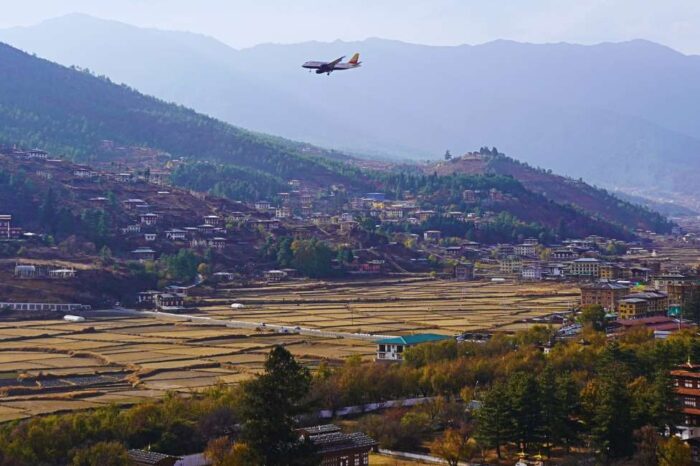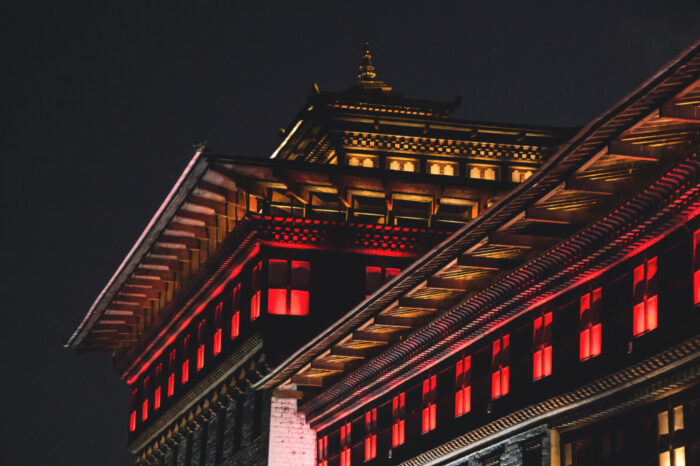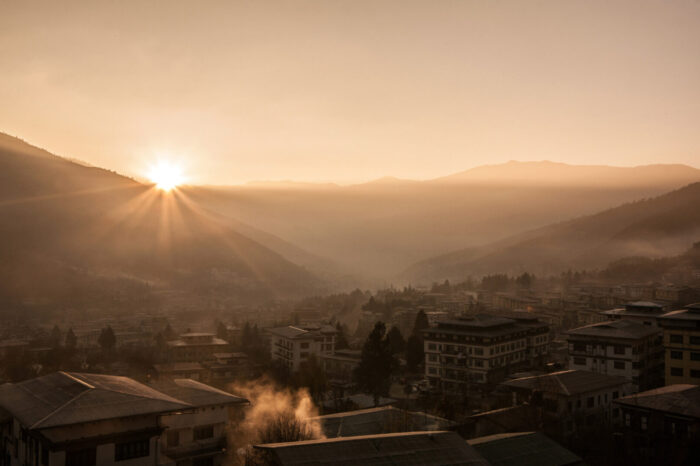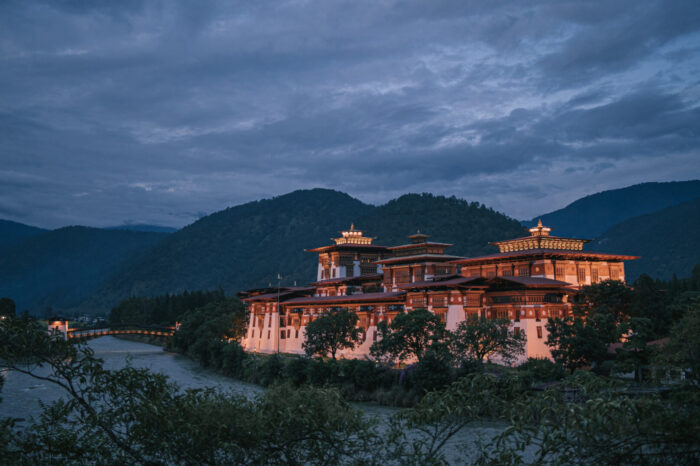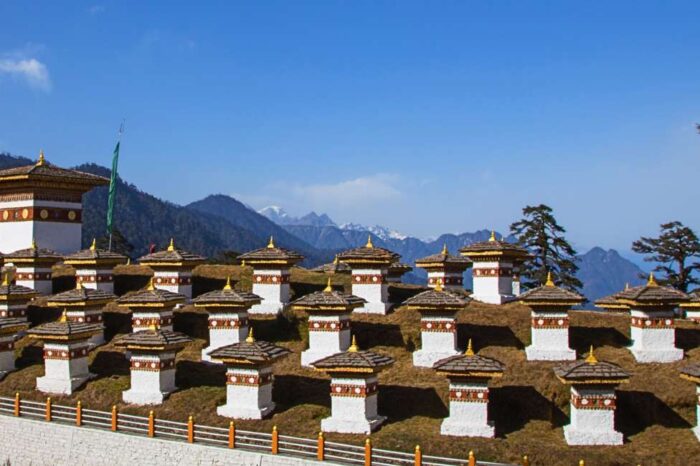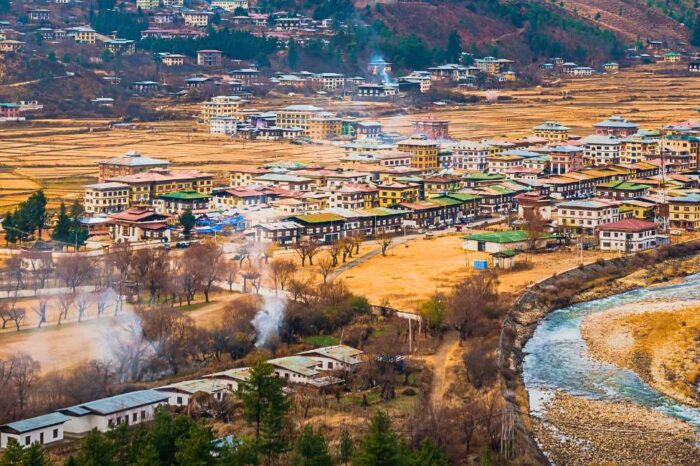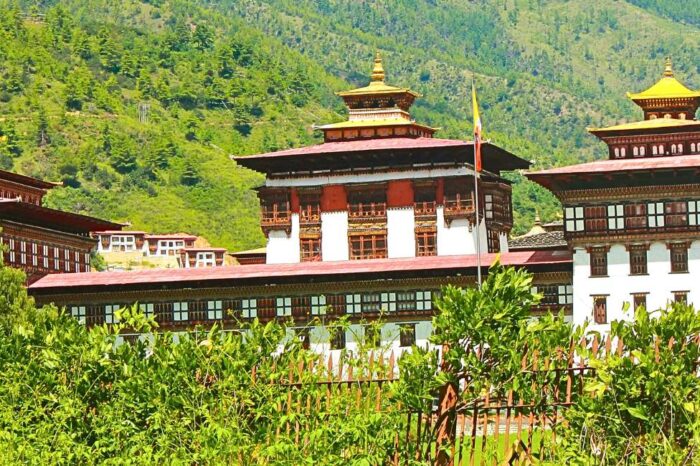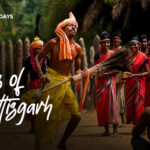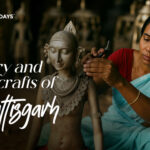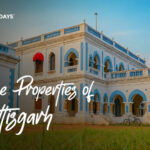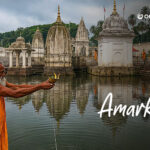- Home
- INDIA
- Offbeat India
- International
- Theme Tours
- Blogs
- Case Studies
- Plan Your Trip
Bhutan
Bhutan Tour Packages
Bhutan, known as the Land of Happiness, is a haven of stunning landscapes, ancient monasteries, and vibrant culture. Nestled in the Himalayas, this serene kingdom offers a perfect blend of natural beauty and spiritual charm. From the iconic Tiger’s Nest […]
Bhutan, known as the Land of Happiness, is a haven of stunning landscapes, ancient monasteries, and vibrant culture. Nestled in the Himalayas, this serene kingdom offers a perfect blend of natural beauty and spiritual charm. From the iconic Tiger’s Nest Monastery to the lush valleys of Punakha and Paro, Bhutan captivates travelers with its rich traditions and warm hospitality. Whether you’re an adventure enthusiast, a cultural explorer, or seeking peace amidst nature, Bhutan promises an unforgettable journey filled with awe and inspiration. Experience the magic of Bhutan and discover why it’s a destination like no other.
Bhutan Tourism: A Serene Kingdom of Happiness
Cut down the noise, slow down the rush. Add a splash of green and a dash of chillies. Dig out every known shade of green in your paint box. Let the mountains rise high. Slip a mask on and dance. Let the flags flutter outside the monastery. This country is a kaleidoscope of impressions—a mélange of sight, sound, and taste. It’s where time stretches out like a contented cat. Where the air is pure, and happiness is measured.
If you’ve lost your smile, Bhutan will find it. If your eye wanders, Bhutan will catch it. If your soul is hungry, Bhutan will feed it.
So why not plan your next trip to this gorgeous country? It’s close to us, serene, and every element of Bhutan tourism will charm and delight. Let’s take a small step outside our borders because a kingdom awaits.
Bhutan Tourism: A Quick Overview
- Continent: Asia
- Capital City: Thimphu
- Official Language: Dzongkha
- Dial Code: +975
- Population: 763,092
- Currency: Bhutanese Ngultrum / Indian Rupee
- Time Zone: GMT+6
- Area: 38,394 sq. km.
Highlights of Bhutan
Cities in Bhutan
Bhutan is like an emerald—it glitters with many shades, each representing its charming cities. Begin with Paro, home to some of the oldest Buddhist monasteries and temples. Paro also hosts Bhutan’s only international airport. Make sure to visit the iconic Paro Taktsang Monastery (Tiger’s Nest), perched 900 meters high on a cliff—a trek well worth the effort.
Next, explore Thimphu, the capital and cultural hub of Bhutan, which is the fourth-highest capital city in the world. Take a trip to the Motithang Takin Nature Preserve, where you’ll meet Bhutan’s national animal, the Takin. Move on to Punakha, the former capital, known for the magnificent Pungthang Dewachen Phodrang (Palace of Great Happiness). If you’re a trekker, Wangdue Phodrang is a must-visit. Trek through stunning landscapes and visit the famous Gangtey Monastery, a peaceful abode nestled in the Black Mountains.
Other notable cities include Trongsa, Bumthang, and Phuentsholing, each offering a unique blend of culture, stunning mountain views, and historical monasteries.
Nature of Bhutan
The Bhutanese have a deep harmony with their environment. The country is a paradise of pristine forests, unspoiled valleys, and rushing rivers. Rich in biodiversity, Bhutan is home to 5,500 plant species, 600 types of orchids, and numerous medicinal plants. For wildlife enthusiasts, Bhutan offers an array of national parks and wildlife preserves such as Royal Manas National Park, Jigme Singye Wangchuk National Park, Thrumshing La National Park, and Bumdeling Wildlife Sanctuary. You’ll find elephants, tigers, golden langurs, yaks, and the rare snow leopard. Bird watchers can spot over 620 species of birds. Bhutan’s rich biodiversity will leave you wanting to explore its natural beauty time and again.
Places of Worship in Bhutan
Bhutan is synonymous with peace and spirituality. While Taktsang Monastery (Tiger’s Nest) is iconic, there are many more temples and monasteries that soothe the soul. Visit Tashichho Dzong in Thimphu with its golden roofs and serene atmosphere. In Punakha, the Punakha Dzong is the second oldest in Bhutan, standing proudly with the blue sky as a backdrop. Chimi Lhakhang, built by the “divine madman” Drukpa Kunley, adds a unique flavor with its humorous and unconventional spiritual stories.
For families, the Changangkha Lhakhang is a temple that blesses children and is often involved in naming infants. Other spiritual sites include Buddha Dordenma (a 51-meter-tall bronze statue of Buddha), Dechen Phodrang Monastery, Gangtey Monastery, and Rinpung Dzong.
Cuisine of Bhutan
Bhutanese cuisine is packed with spice and flavor. The famous Ema Datshi, a stew of chillies and cheese, is a must-try for anyone who can handle the heat. Another staple is Jasha Maroo, a diced chicken stew flavored with garlic, tomatoes, onion, ginger, and, of course, chillies. For a heartier meal, indulge in Phaksha Paa, a dish of stir-fried pork with chillies and bok choy.
Balance the spice with Suja, a butter tea made from fermented yak butter. Vegetarians can enjoy Zow Shungo, made with vegetables and red rice, or Jaju Soup, a creamy dish with local spinach or turnips. And for snacks, don’t miss the crispy rings of gourd fried in butter, known as Khatem.
Interesting Facts About Bhutan
- Bhutan is known as the “Land of the Thunder Dragon” due to violent thunderstorms that frequently occur over its valleys.
- The country measures success through Gross National Happiness instead of Gross Domestic Product.
- Bhutan was the first country in the world to ban tobacco in 2004.
- The national sports of Bhutan are archery and darts.
- Thimphu is the only capital city in the world with no traffic lights, relying instead on white-gloved traffic officers.
- Gangkhar Puensum is the highest mountain in Bhutan and remains unclimbed, as it is considered sacred.
Location of Bhutan
Bhutan is nestled in the Eastern Himalayas and shares its borders with Tibet (China) to the north, Sikkim and Chumbi Valley of Tibet to the west, Arunachal Pradesh in the east, and Assam and West Bengal in the south.
Best Time to Visit Bhutan
Bhutan’s weather varies by region, but generally, the best time to visit is from October to December, when clear skies and sunny days prevail, with a pleasant hint of chill. This is the ideal time to experience Bhutan’s beauty.
How to Reach Bhutan
By Air
Bhutan’s only international airport is located in Paro. You can catch a direct flight via Druk Air from Kolkata, Delhi, Bangkok, Kathmandu, and Dhaka. The closest Indian airport is Bagdogra Airport in West Bengal. The flight to Bhutan offers spectacular views of the Himalayas, including Mt. Everest, Kanchenjunga, and Lhotse.
By Road
There are three border points open for tourists entering Bhutan by road: Phuentsholing, Gelephu, and Samdrup Jongkhar. Phuentsholing is a 4-5 hour drive from Bagdogra Airport, while Samdrup Jongkhar is about 150 km from Guwahati, a 3-hour drive.
By Train
Bhutan does not have a direct rail link. The nearest railway stations are in India at Hasimara, New Alipurduar, Siliguri, and Jalpaiguri. Hasimara is 17 km from Phuentsholing, and you can easily hire a taxi or take a bus to Bhutan from there.
History of Bhutan
Bhutan has never been colonized and has always maintained its independence. Located along the Silk Road between Tibet, India, and Southeast Asia, Bhutan has a rich history as a Buddhist kingdom. In the 17th century, Zhabdrung Rinpoche unified the country under a theocratic government. After a brief civil war in the 19th century, Bhutan began to form relationships with the British Empire, and later, India.
In 2008, Bhutan transformed from an absolute monarchy to a constitutional monarchy, holding its first-ever democratic elections. Today, Bhutan is known for its strong sense of heritage, spirituality, and commitment to Gross National Happiness.
Bhutan is a land of breathtaking beauty, ancient traditions, and spiritual depth. Whether you’re hiking to monasteries perched on cliffs or sipping butter tea by a rushing river, every moment in Bhutan is a step closer to finding peace and happiness.
From cultural immersion to thrilling treks, our Bhutan Tour Packages offer a unique blend of experiences. Let Ocean6 Holidays curate your perfect Bhutan journey with all the above Bhutan Tour Packages. Check the Video from the YouTube Channel of Fernweh Chronicles on Bhutan.
A hearty welcome to the ‘Happiest Country in the World’, Bhutan. Undertake a trip to Bhutan for your forthcoming vacation lapped in serenity. Your desire to escape from the dirt and grime can be fulfilled in this mesmerising land. The little discoveries that you make in this country will make you fall in love with this place. Though you are traveling to a foreign land, yet you do not have to carry a passport or apply for a visa. The Kingdom of Bhutan snuggles between the Eastern Himalayas. This landlocked country has elevated and transformed the meaning of Happiness. Happiness is no more a feeling. It is a place. And this place is called Bhutan; a land of thousand everlasting smiles. The natives call this place ‘Druk-Yul’ which means ‘the land of Thunder Dragon’. A couple of Fun Fundas about Bhutan: The colour of rice in Bhutan is red and chilies form the main dish here.
Bhutan has carved its own stellar identity through its traditions, plurality of cultures, histories, and customs. Bhutan has a rich culture that is deeply rooted in Buddhism. This peace-loving country also embraces the finest things of other cultures and countries. The friendly people of Bhutan live in harmony with one another and other environmental elements. Most of the population lives in villages or in little towns making this place even more engrossing. Bhutan’s national sport is Archery. The mind-bending landscapes and the warm hospitality of the people will make you happy and comfortable. The country is extremely neat and clean and life here begins silently to the soft pulsating vibrations of the traditional actions amidst untainted and delightful countryside. Bhutan is adorned with rich forests, fascinating forts, lush green valleys, ancient monasteries, steep verdant mountains, Buddhist relics among others. Apart from the bounties of nature, there are other man-made wonders also.
Phuetsholing (Land) & Paro (Airport) Entry from India
Bhutan can be reached both by land and airways. If you plan to visit Bhutan by land, you need to reach Hasimara first. From the Hasimara railway station, you need to go to Jaigon which is approximately 14 km. Jaigon is the Indo-Bhutan border which falls on the Indian side. This is where immigration needs to be completed. Head to the Bhutan Immigration Office in Jaigon and get the immigration process done which might take you only 30 minutes. Then proceed towards your destination from Phuetsholing.
Thimphu

Thimpu is the capital of Bhutan. It is also the largest city of Bhutan. Thimphu lies in the western central portion of Bhutan. Wander around the streets to get a feel of the Bhutanese lifestyle. Raidak River flows through Thimpu. Hand-painted flower designs can be seen on the outside of the houses. Many of Thimpu’s contemporary designs, including the supreme court, National Ceremonial Plaza, among others is done by American-Indian Pune based architect Christopher Benninger. Thimpu has an elevation of 7,874ft over sea-level. When in Thimpu, you must try the butter tea made with yak butter in other words known as Salty Suja.
Buddha Dordenma Statue

This statue is perfectly positioned on a summit in the capital city, Thimpu. The Buddha Dordenma Statue is a lofty golden statue. There are approximately 1,25,000 tiny Buddhas hidden is this striking statue. The Buddha Statue was built by a Chinese Company. The Buddha Dordenma statue stands staggeringly tall at 169 meters. This magnificent structure is constructed of bronze and covered with a layer of gold. is situated in Kuenselphodrang Nature Park. This extravagant man-made wonder sits atop a meditation hall.
Dochula Pass

The eldest Queen Mother, Ashi Dorji Wangmo Wangchuk constructed 108 stupas or “Druk Wangyal Chortens” in the loving memory and to honour the 108 Bhutanese soldiers who laid their lives for their motherland. The distance of this pictorial pass is approximately 20 km from the capital city; Thimpu. The beauty cannot be hard to notice with the Mighty Himalayas blanketed in snow surrounds this pass. The charming location is sprinkled with lush green hills. The Dochula Pass has a dizzying elevation of 3100 meters above sea level. During the winters, the Dochula Pass has a completely different avatar, which you have to see to believe it. This pass is undoubtedly the most arresting pass of Bhutan, even though it’s not the highest one.
Punakha

Punakha was once the capital of Bhutan. Punakha is approximately 72 km from Thimpu. This scenic place has an altitude of 4265 feet above sea-level. The winters are warm and the summers are hot in Punakha. The winter season lasts from December to February while the summer season lasts from June to August. The gurgling sounds of Po Chhu and Mo Chhu, the picturesque vistas, the lofty mountains, the Buddhist architecture, all seem to awaken the lively and happy spirit in you. This quaint little town lies in the lap of Himalayan ranges. Punakha is a major producer of rice in Bhutan. Hence it is known as the ‘rice bowl’ of Bhutan.
Punakha Dzong

Punakha Dzong in Western Bhutan is among the most picturesque dzongs in Bhutan. The dzong is set against the backdrop of jade green hillocks. Spring is the harbinger of colours and it dresses up the Dzong and the entire atmosphere in multiple beautiful hues. The lilac jacaranda trees are in full bloom at this time and it looks splendid across the pristine white-washed walls of the edifice. Punakha Dzong is the second largest dzong in Bhutan and also the second oldest. It also serves an official purpose. The dratshang or the official body of the monks utilizes this dzong as their home during the winter season. An amazing fact about this structure is that it is constructed without a single nail! This note-worthy structure accommodates and protects a major portion of Bhutan’s national treasures. This scenic dzong snuggles betwixt Mo Chhu and Pho Rivers and therefore you are required to cross the ‘Bazam’ to get to it. The dzong has a steep wooden staircase that can be pulled up and a burly wooden door that is closed at night.
Phobjikha Valley

Unlike other valleys, Phobjika Valley is a bowl-shaped valley enwreathed by the attractive Black Mountains. This valley is a delight to nature lovers. River Nakey Chhu runs through this valley. The valley is positioned on the edges of Jigme Singye Wangchuck National Park. A large number of feral beauties such as red foxes, black-necked cranes, wild boars, serows, etc. are found here. One will be at a loss of words to describe the beauty of this glacial-valley. Phobjika Valley is also called the Gante after the Gangtey Monastery. Gangtey hikes and treks are extensively famous for the tourists. A very famous crane festival takes place in the month of November. The tourist season begins in October and lasts until December.
Paro

Paro is a place whose spotless natural beauty is wondrous. Its untarnished wilds and age-old traditions make it a land that is liked by millions. It has an equal amount of splendid scenery and boisterous history with a good sprinkle of modernism in it. This town has many buildings from the bygone era. Paro is the centre of adventure sports in Bhutan. Whether it’s kayaking, trekking, rafting, mountain biking or hiking, you will get a chance to do it all in Paro. The traditional buildings, fertile rice paddy fields, lush mountains, green valleys, and other natural wonders accentuate the beauty of this stunning place.
Tashichho Dzong

Tashichho Dzong lies on the northern fringes of the capital city of Bhutan, Thimpu. This dzong of bliss is a fortress and a monastery and stands upon the west bank of the Wang Chu River. From the year 1952, it serves as the headquarters of the government and at present, it has offices of the king, the throne room and few others. Emerald green mountains surround the buildings. On the west side of the dzong, there is a small tower. A statue of Shakyamuni Buddha along with other Gods and Goddesses are placed there. This dzong has manicured gardens and well-maintained lawns.
Taktsang Palphug Monastery, Paro

This Cliffside monastery is also called Paro Taktsang and its most famous name is Tiger’s Nest. Situated at an altitude of 3120 meters over sea-level, Tiger’s Nest is a notable tourist destination of Bhutan. Legend has it that Guru Padmasambhava better known as Guru Rinpoche flew to this place on the back of a tigress from Tibet. Guru Padmasambhava is believed to have been mediated in a cave during the 8th century and he is given credence to have brought Buddhism to Bhutan. Tsechu is a popular festival that is held in Paro Valley in the months of March or April in loving memory of Guru Padmasambhava
A visit to the breathtaking monastery will sculpt many remarkable memories and experiences in your life. The impressive views of the soaring mountains and lush green valleys which ensconce the Taktsang Palphug Monastery give it a lordly appearance. Rhododendrons and the Blue pines add to its glory. Due to its solitary location, the monastery can either be reached by hiking or by a horse. A round trip hike will take approximately 6 hours including site-seeing of the monastery. You can also have lunch from the monastery café. A new day arrives with the monks spinning the prayer wheel kept in the yard precisely at 4 am. If you are visiting anytime from October to March then the timings are from 8 AM to 1 PM and if you visiting between the months of April to September, the timings are from 2 PM-5 PM.
Chele La Pass

Chele La Pass is situated between the scenic valleys of Paro and Ha. Chele La Pass is located at an elevation of 3810 meters above sea level. This is the highest pass in the country and is a major tourist destination in Bhutan. Chele La Pass tops the list as the highest motorable pass of Bhutan. You will be greeted with verdant and pristine mountains and larch forests on your way to this majestic Chele La Pass. Chele La Pass is very famous for hiking and mountain biking. The pass presents a great point of viewpoint for looking at Mount Jumolhari and Jichu Drake on a clear sunny day. Rhododendrons adorn this place during from April to June and are besotted with a very soothing climate. The summertime is for camping and picnicking and the cold winters are for viewing the vibrant landscape wreathed in snow. The scenery is amazing at both times.
Haa Valley

Nestled in the mountains of Bhutan is an incredible valley known as the Haa Valley. Haa Valley is perched at an altitude of 2670 meters. This virgin place is a new tourist spot on the tourist map of Bhutan. The Haa Valley itself lies in between the Samtse, Paro, and Chhukha districts of Bhutan. The surreal vistas of this place will leave you speechless and explore its beauty by bike and walking trails. The Haa Valley is very near to Zhoglam or Doklam. This is the ancestral home of the Dorji family and the Queen Grandmother. The picturesque Haa Town is sparsely populated and is renowned for its customs and tranquility. Haa Valley is dotted with lush mountains and extensive grasslands. This paradise of a valley has a vast diversity of flora and fauna. This is an ideal place for nature aficionados.
Takin Zoo or Motithang Takin Preserve

This zoo in Thimpu is situated in the Motithang district. The National Animal of Bhutan is Takin and this zoo is home to this unique creature. The body of this animal is of a cow and the head id of a goat. Takin is also known by two other names; gnu goat and cattle chamois. The Nature Conservation Division of Bhutan is working hard to save this endangered species.
Bhutan Tour FAQs
Q: What are the must-see attractions in Bhutan?
A: Bhutan boasts a wealth of captivating sights, including the iconic Tiger’s Nest Monastery, the majestic Punakha Dzong, the serene Phobjikha Valley, and the bustling capital city of Thimphu.
Q: What type of accommodation can I expect on a Bhutan tour?
A: Our Bhutan Tour Packages offer a range of comfortable accommodations, from cozy guesthouses and traditional farmstays to luxurious hotels, ensuring a pleasant stay for all travelers.
Q: What is the food like in Bhutan?
A: Bhutanese cuisine is a delightful blend of flavors, featuring dishes like Ema Datshi (spicy chili and cheese stew), red rice, and Momos (dumplings). Vegetarian and other dietary preferences can be easily accommodated.
Q: What kind of activities are included in the tour packages?
A: Our Bhutan Tour Packages offer a diverse range of activities, including guided sightseeing tours, cultural immersions, nature walks, hikes, and opportunities to interact with the locals.
Q: Is Bhutan safe for solo female travelers?
A: Bhutan is considered a safe destination for solo female travelers. The country’s strong cultural values and low crime rates contribute to a secure environment.
Q: What should I pack for a trip to Bhutan?
A: Pack comfortable walking shoes, layered clothing for varying temperatures, a rain jacket, sunscreen, and insect repellent. Remember to dress modestly, especially when visiting religious sites.
Q: Can I customize my Bhutan tour package?
A: Absolutely! Ocean6 Holidays offers flexible itineraries, allowing you to tailor your Bhutan Tour Package to suit your specific interests and preferences.
Q: How do I book a Bhutan Tour Package?
A: Contact Ocean6 Holidays directly to discuss your travel plans and preferences. Our team will assist you in creating a personalized itinerary and booking your dream Bhutan adventure.
Q: Are there any additional fees or taxes not included in the package price?
A: The package price typically covers accommodation, meals, transportation, guide services, and entrance fees. However, it’s advisable to clarify with Ocean6 Holidays if there are any additional costs or taxes applicable.
Q: What is the tipping etiquette in Bhutan?
A: Tipping is not mandatory in Bhutan, but it’s a gesture of appreciation for good service. If you wish to tip your guide or driver, a small amount is sufficient.
Remember, we are here to help you plan an unforgettable Bhutanese journey. If you have any more questions, please don’t hesitate to reach out to Ocean6 Holidays.
Experiences
- Waterfalls of ChhattisgarhOctober 29, 2025
- Tribals of ChhattisgarhAugust 12, 2025
- Jewellery and Handicrafts of ChhattisgarhAugust 12, 2025
- Heritage Properties of ChhattisgarhAugust 12, 2025
- Amarkantak TourJune 17, 2025
- Waterfalls of Chhattisgarh
Call
98742 84569
98743 61951
Mon-Sat 11.00AM-07.30PMNewsletter
Rate & Review Us
Contact Info
- +91 98742 84569
- experience@ocean6.in
- 16, Suren Tagore Rd, Ekdalia, Ballygunge, Kolkata, West Bengal 700019
- Mon - Sat : 11.00 AM - 7.30 PM
Sunday : CLOSED
Newsletter
Quick Links
